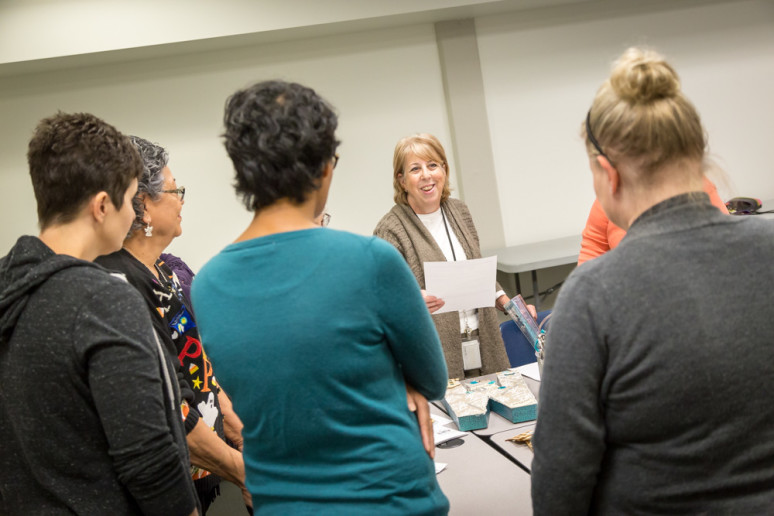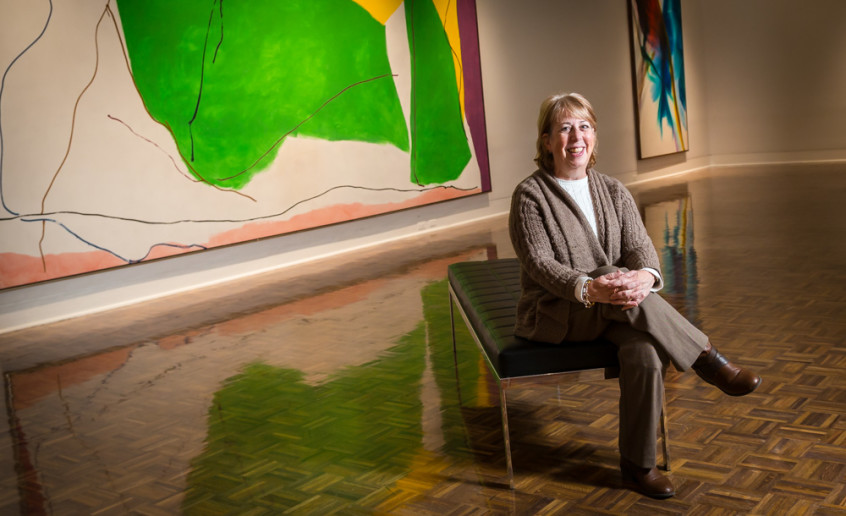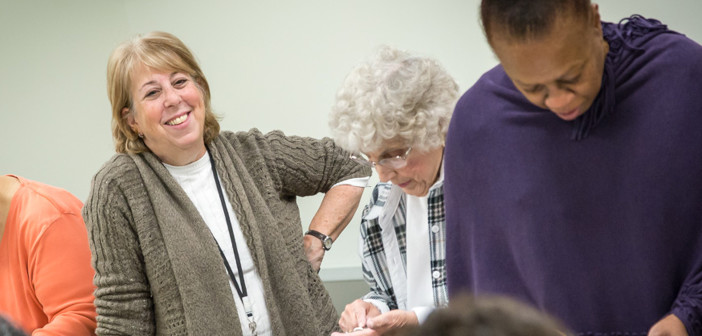After earning master’s degrees in counseling and art therapy, Gail M. Singer, MA, LPC, ATR wasn’t sure what her focus would be. She explains, “I was at the end of my schooling and about to start my final internship practicum … when I was diagnosed with breast cancer. My children were 5, 11 and 13 and I went through surgeries, chemo and radiation. During treatment, my social worker at the treatment facility asked me to do my internship there. And long story short, I’ve been working with cancer patients ever since.”
 Almost 12 years ago, McLaren Flint was looking for an art therapist to collaborate with the Flint Institute of Arts on a brand-new Healing Through Art program. Singer was hired and developed the program, which consists of workshops at the Karmanos Cancer Institute at McLaren Flint taught by an Art School instructor, and workshops run by Singer at the FIA twice a month. Each FIA session begins with a docent – an FIA employee – leading the workshop participants in discussion of a preselected art piece. Singer explains, “We meet and discuss a piece that I thought had relevant themes. Then, we go back to the art room and work on that day’s project. I give them prompts, but they can take it wherever they need to go, which is always the point. It has to be open-ended enough for them to feel free to take it in the direction they need to take.” She adds that during the workshop, there is a lot of laughter; but when they come together at the end to discuss the project, that is when stronger emotions are expressed.
Almost 12 years ago, McLaren Flint was looking for an art therapist to collaborate with the Flint Institute of Arts on a brand-new Healing Through Art program. Singer was hired and developed the program, which consists of workshops at the Karmanos Cancer Institute at McLaren Flint taught by an Art School instructor, and workshops run by Singer at the FIA twice a month. Each FIA session begins with a docent – an FIA employee – leading the workshop participants in discussion of a preselected art piece. Singer explains, “We meet and discuss a piece that I thought had relevant themes. Then, we go back to the art room and work on that day’s project. I give them prompts, but they can take it wherever they need to go, which is always the point. It has to be open-ended enough for them to feel free to take it in the direction they need to take.” She adds that during the workshop, there is a lot of laughter; but when they come together at the end to discuss the project, that is when stronger emotions are expressed.
Singer emphasizes that the art therapy workshops are often misinterpreted. “When people hear ‘art therapy,’ they think the emphasis is on the art, but actually, the emphasis is on therapy,” she says. “Art is a tool to help people improve their lives in some way. It relies on the brain always processing information, so sometimes when people think that they are doing something randomly, or because it’s pretty, they often discover that it has a deeper meaning for them. Part of the therapist’s job is to help them figure out, through discussing their art, what may be preventing them from moving forward.”

Singer finds that for cancer patients, specifically, art is a way for them to express anxiety and depression, and to help decrease their stress and tiredness. But more importantly, it is a way for them to find their voice and work through concerns. “I think a lot of people don’t realize that many patients feel like they lose their voice and identity,” Singer shares. “They don’t look like themselves, they don’t feel like themselves. And what happens at the end of treatment, is that everyone assumes, ‘you’re all done and everything will return to normal, right?’ What the cancer survivor thinks is, ‘I am not the person that I was and I am never going to get that person back.”
Singer explains that most art therapy participants have enrolled after they finish treatment, since it can help them address new and recurring emotional needs. “The nice thing about art is that while you may not know how to change your life immediately, you can change the artwork – and by changing the artwork, you might be able to change your life. It gives back some control and power,” she emphasizes.
“What I hope happens in the workshops as they take authority over their process, is that their voices are going to become stronger and more individual,” Singer says. “When that happens, the work becomes more powerful, always, because you are speaking with more authenticity.” She continues, “there is so much silencing that goes on during the treatment process. People are told things like, ‘a good attitude will get you through this and make everything better,’ and instead you’re thinking, ‘Well, I’m depressed and angry at the moment, but I’ll get back to you about the happy thing.’ One of her goals is to make them feel empowered; that it is okay to feel however they feel during the treatment and recovery process. She also hopes that by strengthening their voices, they will be able to take more authority over their lives, and their treatment, as well. “Maybe it will empower them to speak up about their treatment when they need to; maybe one nurse is gentler, or they want a second opinion – either way, they should have a voice to ask for what they need from their care providers.”
 Singer believes this collaboration with the FIA is one-of-a-kind partnership. “It’s unique to Flint and it’s a lovely thing to have people totally on board with it; to have the doctors, nurses, artists and everyone else involved understand that what I am doing is different, and they’ve begun to refer patients to this program.” Karmanos Cancer Institute at McLaren’s Healing Through Art program also offers individual sessions where patients can meet one-on-one with the Singer, and she is available for support group sessions, as well. The Healing Through Art programs are a complimentary resource to cancer patients and are funded through private donations.
Singer believes this collaboration with the FIA is one-of-a-kind partnership. “It’s unique to Flint and it’s a lovely thing to have people totally on board with it; to have the doctors, nurses, artists and everyone else involved understand that what I am doing is different, and they’ve begun to refer patients to this program.” Karmanos Cancer Institute at McLaren’s Healing Through Art program also offers individual sessions where patients can meet one-on-one with the Singer, and she is available for support group sessions, as well. The Healing Through Art programs are a complimentary resource to cancer patients and are funded through private donations.
Singer recounts that the sessions at the FIA are about being a community and being social, which makes for a lot of talking and laughing, “but sometimes the whole room can get very quiet. That is great, because it means they have become completely absorbed in what they are doing, and they’ve been freed from their anxiety for a little while, and are simply focused on creating.”
For more information on the art therapy program, contact Karmanos Cancer Institute at 810.342.4206 or email gasinger@mclaren.org.
“This program is unique to Flint and it’s a lovely thing to
have people totally on board with it.” – Gail Singer
Photography By Eric Dutro














